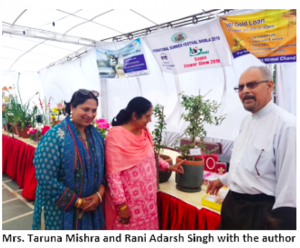The other day, my potted ivies exhibited in the INTERNATIONAL SUMMER FESTIVAL SHIMLA- SAGES Flower Show were ‘objects to envy’; even a gardener turned activist insisted to hide the tag; may be to ward off the Evil Eye.
- Ivy is an attractive and symbolic Plant; indoor and outdoor ornamental vine. Called a clinging vine, ivy attaches itself to surfaces with holdfasts, suction pads and rootlets; a woody evergreen Eurasian climbing plant, typically having shiny, dark green five-pointed leaves.
- It’s a climbing, trailing, and creeping vine that forms dense coverings over trees and other supports. The tiny hairy roots grow into any small crevices available, secrete glue-like nanoparticles, and lignify.
- The plant is often admired for its beautiful appearance on the walls of buildings. Ivy covering the walls of an old building is a familiar and often attractive sight. It has insulating as well as weather protection benefits, dries the soil and prevents wet walls.
The clinging nature of ivy makes it a symbol of love and friendship. There was once a tradition of priests giving ivy to newlyweds.
- Ivy has traditionally been imbued with a spiritual significance. It was brought into homes to drive out evil spirits: varieties with variegated leaves adore Hanging gardens of Bua Rani.
- In Ancient Greece wreaths of ivy were used to crown victorious athletes. In Ancient Rome it was believed that a wreath of ivy could prevent a person from becoming drunk, and such a wreath was worn by Bacchus, the god of intoxication, where the plant represents female divinity.
- As it clings to dead trees and remains green, it was also viewed as a symbol of the eternal life of the soul after the death of the body in medieval Christian symbolism.
Ivy-covered ruins were a staple of the Romantic Movement in landscape painting.
- In Europe, it is frequently planted to cover walls and they recommend growing it on buildings for its ability to cool the interior in summer, while providing insulation in winter, as well as protecting the covered building from soil moisture, temperature fluctuations and direct exposure to heavy weather.
- Further uses include weed suppression in plantings, beautifying unsightly facades and providing additional green by growing on tree trunks. Variegated ivy is a popular choice for covering fences; is grown primarily for its evergreen leaves and can be classified as foliage plant.
- It is Hedera, Botanically speaking , commonly called ivy (plural ivies). They are also classified as woody vines. Old regional common names in Britain, no longer used, include “Bindwood” and “Lovestone”, for the way it clings and grows over stones and bricks. Regional common names include the generic “English ivy”.
- Ivies are of major ecological importance for their nectar and fruit production, both produced at times of the year when few other nectar or fruit sources are available.
Growing in Containers
- At home indoors or out, ivy does well planted in containers or baskets; where its trailing vines can hang down. This, indeed, considering their invasive quality, is a very sensible way in which to grow the vines for their beauty without having to worry that they will spread out of control.
- Ivy will need protection from winter winds as well as the hot summer Sun , plants grow well in part shade to full shade.
- Water the plant sparingly; too much water suffocates it. They do prefer a consistent temperature and medium to high humidity to keep up their dark green leaves.
- Do not use fertilizer or plant food if the plant is in a stressful situation: very hot, very cold, very dry soil, or leaf production that has stopped.
- We can repot small ivy plants every year into fresh potting soil, or every other year for larger plants. Old, tired plants can be refreshed and planted back into their same containers.
- Ivies propagate readily from stem cuttings. Because they are trailing plants, ivies benefit from trimming—use these trimmings to propagate your plants. Take cuttings 4 to 5 inches long and place them in water until a good network of root hair has developed, then plant in potting soil.
- The fact that ivy plants spread quickly means that they could be useful as ground covers for filling in hard-to-plant spots in landscaping. Trim this ground cover in the spring to keep it manageable and discourage bacterial leaf spot. Spray with neem oil and insecticidal soap as necessary to control mites.
- Their aggressive nature suggests that they could be effective allies against erosion on hillsides.
- However, ivy can be problematic. It is a fast-growing, self-clinging climber that is capable of causing damage to brickwork, guttering, etc., and hiding potentially serious structural faults, as well as harbouring unwelcome pests. Careful planning and placement are essential. Therefore, if a green facade is desired, this decision has to be made consciously, since later removal would be tedious, leaving an unsightly “footprint” on walls, and possibly resulting in expensive resurfacing work.
- As regards trees, the fact is that any vigorous vine can hurt a tree because the leaves of a vine growing in a tree’s canopy will block sunlight that would otherwise be used by the tree’s leaves in photosynthesis. The added weight from vines is also an unnecessary burden on any tree with stability issues.
‘Your Ivy creeper is attractive’ I said- looking at, on our morning walk over Forest Hill Road. He showed me in for the early tea.
“Our Ivy suffered stress during the renovation period. Now after a year or so, it has regenerated; we believe it greens the whole house. It is quick growing” says Surya of ‘SUDS Villa’
……………………………………………………………………………………………………………..
Prof. (Er.) Chander P Mahajan is an art critic & a free lance journalist. The Environmentalist stays in Shimla and Dalhousie, Himachal Pradesh, India.





